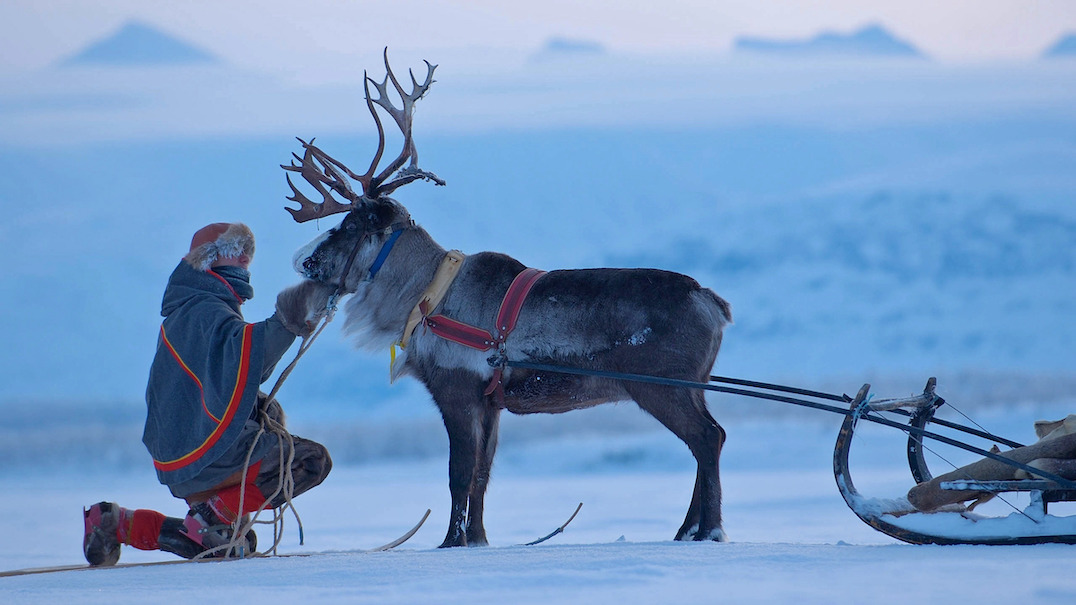Sámi rights must not be sacrificed for green energy goals of Europe

- Last week, the European Commission released the Critical Raw Materials Act for minerals used in renewable energy and digital technologies.
- It mandates that EU countries should be extracting “enough ores, minerals and concentrates to produce at least 10% of their strategic raw materials by 2030,” and part of that looks likely to come from mines on Indigenous Sámi land.
- Mines already sited there have caused pollution, devastated ecosystems, poisoned reindeer forage, and taken away their reindeer grazing areas. “How can this transition be sustainable if it destroys our land and violates our Indigenous and human rights?” a new op-ed asks.
- This post is a commentary. The views expressed are those of the author, not necessarily of Mongabay.
Growing up in Gällivare/ Váhtjer, a Swedish village in Sápmi, north of the Arctic Circle, the threats facing Sámi people were a daily reality.
We are Europe’s only Indigenous people, but colonialism means our territory, Sápmi, is split across four countries: Sweden, Finland, Norway and Russia.
But across these national borders, the same pressures bear down on us, from mining to forestry and wind farms.

For outsiders’ commercial gain, our land has been seized, our people displaced, and the reindeer herding that’s been the foundation of our lives for millennia, eroded.
Adjacent to my village is Malmberget, a scene of deep mine iron ore extraction, and a little over 100 kilometers away is Kiruna, the world’s largest underground iron mine. Both are owned by Luossavaara-Kiirunavaara AB (LKAB), the 100% state-owned Swedish mining company.
Kiruna is one of the nine out of 12 mines in the north of Sweden which are on Sámi land. These mines – as well as the infrastructure accompanying them – have caused pollution, devastated ecosystems, poisoned the lichen that our reindeer survive on, and taken away our reindeer grazing areas.

More mining
Now a new danger has emerged.
European Union policymakers want to secure the ‘critical raw materials’ which its Member States need for the green energy and digital transitions. They’ve identified 30 raw materials as being of vital strategic and economic importance.
By 2030, according to a report based on the draft text of the European Commission’s Critical Raw Materials Act (CRMA), which was just released on March 16, EU countries should be extracting “enough ores, minerals and concentrates to produce at least 10% of their strategic raw materials by 2030.”
This will mean that they want to increase mining on our land.
Mineral rush
In January, LKAB announced that it had found Europe’s largest deposit of rare earth elements north of Kiruna. They calculated that the deposit contains at least one million tons of rare earth oxides, minerals used in everything from electric vehicles to wind turbines to mobile phones.
As the rush to extract these and other critical raw materials intensifies, the Sámi people are being told that we have to ‘co-exist’ with mining. Yet co-existence always means us moving and changing our traditional way of life: a way of life that has existed alongside nature for a long, long time.
We are also told that these operations are sustainable and part of the green energy transition. But how can this transition be sustainable if it destroys our land and violates our Indigenous and human rights?

The United Nations has criticized the Swedish, Finnish and Norwegian governments for violating Sámi rights in the past. For example, in 2020 the UN Committee on the elimination of Racial Discrimination condemned Sweden for ignoring Sámi rights by establishing a mine in Rönnebäck. It also called on Sweden to revise its mining legislation to ensure that it respects and complies with the Sámi people’s rights, saying that Swedish law didn’t provide the Sámi reindeer herding community with a real opportunity to have the legality of the mining project tested before the courts.
And earlier this month, the Norwegian government was forced to apologize to Sámi reindeer herders for violating their rights by issuing licenses to operate wind farms on the Fosen peninsula, after the Supreme Court ruled in the herders’ favor.
The overwhelming message in these cases – and throughout Sámi history – is that we must have a say in any decisions that fundamentally affect our lives.
As such, our right to Free, Prior and Informed Consent (FPIC) to any mining, wind farms or forestry on our land should be sacrosanct: FPIC is a fundamental right, not merely a principle, as the Swedish government claims.
The EU must also recognize and support this right. A good start would be by enshrining FPIC in the CRMA.